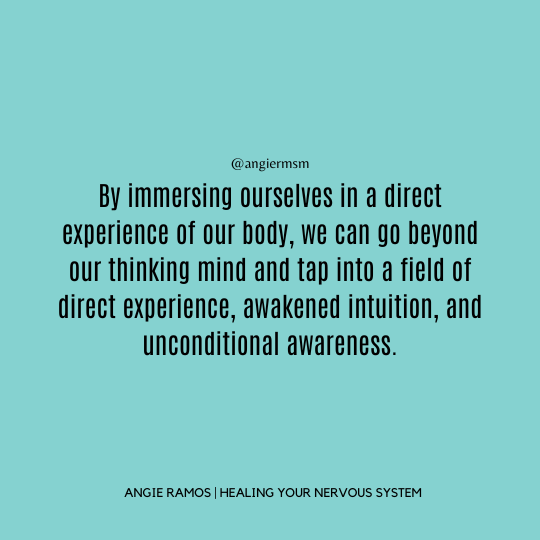Meditation is a practice that has been utilized for thousands of years to bring about several benefits for both the mind and body. However, traditional meditation approaches typically concentrate primarily on the mind, breathing, or mindfulness, without fully connecting with the body.
Numerous scientific studies have shown that meditation has great benefits not only mentally and emotionally but also physically. However, utilizing it as a “fix-all” solution for all kinds of problems and symptoms can be challenging. For those of us who experience dissociation as a result of emotional trauma, it may exacerbate the issue by keeping us disconnected from ourselves and our emotions.
Somatic meditation, on the other hand, is a distinct way of meditating that emphasizes the connection with the physical sensations of the body. By focusing on the body in a conscious and compassionate way, somatic meditation can help us in our emotional healing process by allowing us to start connecting with our body, emotions, and sensations.
What are somatic meditations?
Somatic meditations encourage you to direct your attention inward and focus on your physical sensations, movements, and bodily experiences. Unlike regular meditation, which involves controlling your thoughts and focusing solely on your breathing, somatic meditations aim to help us be present in our sensations, body, and emotions.
Somatic meditation involves a bottom-up process, in which we connect with the sensations of our body and begin to reconnect with it again, instead of using a top-down approach (from head to body), as is the case with cognitive therapy or talking.
Somatic meditations with a trauma and nervous system focus can help us not feel overwhelmed as we begin to connect with our body and sensations. That’s why many health professionals are now including somatic meditations in their practices.
Popular forms of somatic meditation include various techniques that involve direct awareness and attention to the body. Some of these techniques are:
- Scan the body: This involves paying slow and deep attention to every part of the body while being aware of both pleasant and unpleasant sensations.
- Tai-chi / qi-gong meditation: This meditation technique involves gentle and conscious movements that involve the entire body.
- Touching and hugging body parts: This technique involves caressing a specific body part and feeling the sensations that arise.
- Guided body meditations: This technique involves following auditory instructions to feel different body regions.
- Dance/conscious movement: This technique involves freely expressive movement or dance that makes the body in movement conscious.
By immersing ourselves in a direct experience of our body, we can go beyond our thinking mind and tap into a field of direct experience, awakened intuition, and unconditional awareness.

Benefits of somatic meditations:
Somatic meditations have the ability to address emotional and psychological issues that are stored in the body. Many of us tend to carry stress, trauma, and unresolved emotions in our physical bodies, which can lead to tension, discomfort, and even illnesses. Somatic meditations provide a safe space to explore and release these stored emotions, which promotes deep healing and emotional resilience.
In contrast to traditional meditation, somatic meditations encourage us to fully accept what arises within us, instead of overlooking or dissociating from uncomfortable sensations. By cultivating this awareness and acceptance of our bodily experiences, we can learn to listen to our body’s wisdom and respond to our emotional needs with compassion and self-care.
Furthermore, somatic meditations offer practical tools to regulate the nervous system and manage stress responses. By using gentle movement, conscious breathing, and body scanning techniques, somatic meditations help calm the nervous system, promote relaxation, and restore a sense of balance and inner harmony.
Here’s a revised version of the text with spelling, grammar, and punctuation errors corrected:
In summary, deep body awareness can offer the following benefits:
– Reduction of stress and anxiety: Focusing on the body can help release built-up tension and disconnect from stressful thoughts.
– Better management of chronic pain: By facilitating disconnection from painful experiences, it can increase pain tolerance.
– Better sleep: Deep body awareness promotes healthier sleep patterns.
– Increased self-awareness: Being attuned to the body can help you detect patterns associated with emotions and behaviors.
– Greater ability to face difficult emotions: It can facilitate the emergence and processing of traumas stored in the body.
– Reduction of post-traumatic stress: This practice can help release painful memories stored in the muscles.
– Improvement of emotional well-being: It promotes the acceptance and integration of past experiences.

Difference from traditional meditation:
Somatic meditation and traditional meditation differ in their approach. While traditional meditation focuses on the mind and thoughts, somatic meditations integrate body and emotional awareness into the practice.
Somatic meditations allow for a deeper exploration of physical sensations and emotions, leading to a more intimate connection with the body and its messages. It allows access to deeper levels of emotional processing by working directly with memories and traumas stored in the body.
A key difference between the two types of meditation is that somatic meditation does not involve ignoring or fighting unpleasant sensations. Instead, it welcomes them with curiosity, openness and compassion, making it easier for them to emerge naturally without force or judgment.
In my experience working with the nervous system, I have come to understand that traditional meditation is not always helpful. My nervous system was often frozen, making it easier for me to dissociate while meditating. However, for many of my clients, when their nervous system is in fight or flight mode, it can be difficult to calm the mind and achieve meditative states. This is because the nervous system is designed to keep us safe, and when it senses danger, it wants us to fight or flee, not meditate.
It is important to understand that our body is designed to protect us, and if it senses danger, even if it is only perceived, it will trigger a survival response. This can make it difficult for some people to meditate. If you have ever struggled with meditation, it’s important to remember that your body is simply trying to keep you safe. By learning to regulate your nervous system, you can create a more conducive environment for meditation.
How they can help in emotional healing:
Somatic meditations provide a comprehensive approach to emotional healing by integrating the mind, body, and emotions. These practices help us cultivate body awareness and acceptance of our inner experiences. By doing so, we can undo unconscious patterns, release trapped emotions, and restore emotional balance.
One of the most significant advantages of somatic meditation is its ability to facilitate the healing of emotional trauma stored in the body on a physical and energetic level. This happens because our bodies tend to encapsulate painful or emotionally intense experiences in muscular and postural areas.
During somatic meditation, by compassionately paying attention to these areas, associated memories gradually surface. This reduces the emotional load by allowing its expression and release in a non-forced way.
Moreover, somatic meditation helps us recognize body patterns associated with emotions such as fear, anger, sadness or others. This allows us to better understand the origins of certain blocks or behaviors. The self-acceptance and forgiveness promoted by somatic meditation helps in healing.
In short, somatic meditation is an effective approach to releasing encapsulated emotional trauma and promoting healing on a physical, mental, and spiritual level. It involves directing awareness and attention fully to the sensations of the body in a compassionate way.
Somatic meditations are safe to work with as they allow us to access the sensations in our body without having to label or name the emotion progressively. If, at any time, the sensations become too intense or overwhelming, we can redirect our attention or focus on other parts of the body that have sensations to help us stay present.
Conclusion
Somatic meditations are an effective way to achieve emotional healing and personal growth. They help us understand the connection between our mind and body, leading to a more profound sense of well-being and wholeness in our lives. If you’re looking to strengthen your emotional health and find greater inner harmony, it’s a good idea to include somatic meditations in your daily practice. Your body and mind will thank you for it!






0 Comments